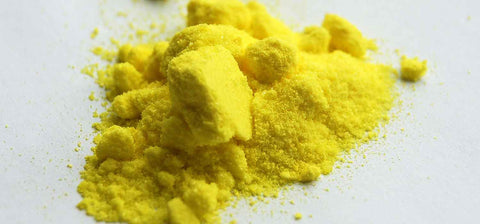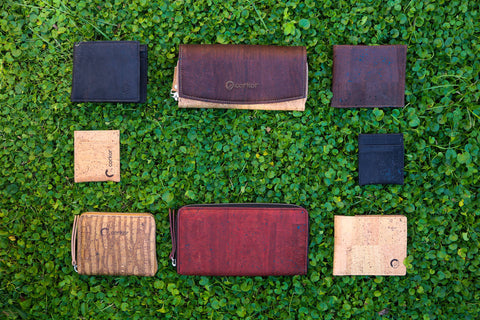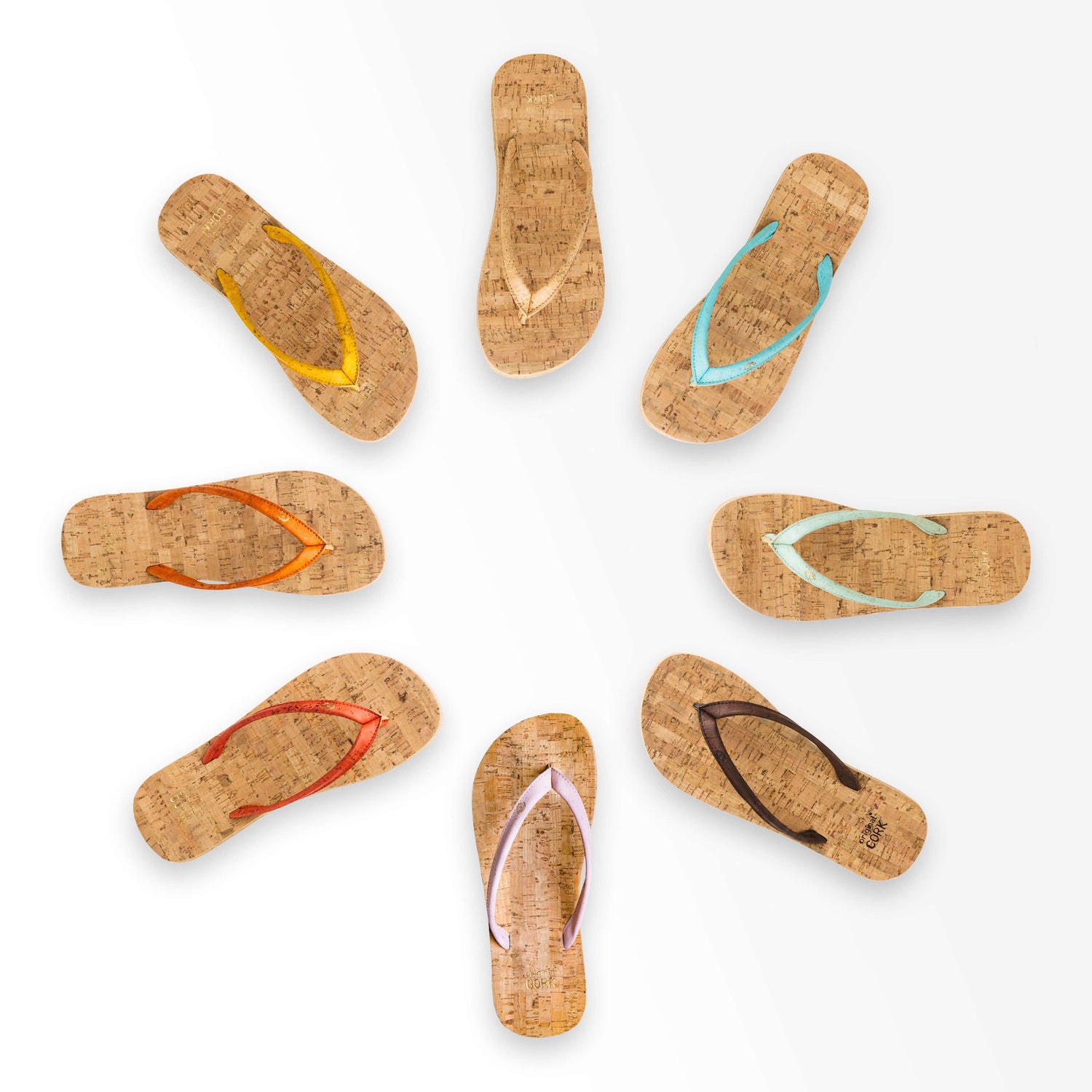Cork or Leather, Which is Better?
Leather is everywhere in today’s world, and it is widely used in fashion to make all types of clothes and accessories - jackets, belts, wallets, pants - you name it. Now, I understand what people like about leather. Leather has physical characteristics that can make it appealing from an aesthetics standpoint, such as its smooth feel and shiny, polished look. Leather is also widely praised for the longevity and durability of the material. Besides, people are accustomed to using leather - often leather substitutes are viewed as "embarking into unknown territory," which can feel intimidating to decipher. However, although leather is still viewed as a luxury, chic product, it is not without its downside. And the more I’ve learned about the modern production of leather, the more I see just how great that downside is.
Cork, on the other hand, is much less widely known, and sometimes a bit misunderstood. But, it is the plant-based equivalent of leather in terms of its material characteristics, with none of the animal cruelty involved in the production of leather.
So let's break it down and examine leather and cork for comparison's sake. Rather than beginning with talking about the finished products of cork and leather and their qualities and characteristics, let's begin at the raw material stage and work our way through their production to discussion of the end products.
Starting at the source, where do leather and cork come from, and how are they made?
Modern Leather - A Natural Product?
In the traditional, small-scale leather making of the past, natural processes were used in which the leather was tanned and dyed with natural plant barks, such as oak bark. Small numbers of animal hides would be turned into leather in order to utilize the whole of an animal, and not let its parts be wasted.
Many people rationalize the modern use of leather thinking that this still how leather is made on an industrial scale. But the truth is, only very few leather producers are using these traditional methods of leather production nowadays.
Unfortunately, the methods used by today’s industrial modern leather industry are far removed from the natural processes of their predecessors. Industrial leather production is rife with animal waste run off, chemical pollution, and dangerous working conditions.
So let's have a look at the behind-the-scenes of most modern leather production.
Leather Production: Animal Product and Chemical Waste
Leather is not just a by-product of the meat and dairy industry, but due to the ever-increasing Western demand for leather products, animals are killed just to produce leather.
Leather facilities create air pollution from organic solvents (VOCs) used in processing the animal carcasses, solid waste in terms of what is referred to as rawhide waste, and water pollution from the wastewater released from the facilities. Rawhide, or “raw animal hide” waste, consists of animal body parts unable to be used for leather production that are disposed of as waste. These animal organs, skins, and the accompanying blood often are disposed of in local waterways around leather production facilities, contributing to the wastewater produced by the facility.
Chromium Tanning
One of the most concerning aspects of the modern chemical tanning process of leather is that it makes use of a heavy metal called chromium, which is highly bio-accumulative and toxic.

Potassium Chromate
Chromium is not something you want to mess around with. It is considered an extremely hazardous substance, and exposure causes diseases in leather factory workers exposed to it. Dermatitis can also occur upon contact with the skin when working with the metal or even when wearing a chromium-tanned garment. It also has been linked to asthma, bronchitis, other respiratory problems, and cancer. It is a potent water pollutant, creating hazardous runoff into waterways that is difficult to clean up.
Some people defend the use of chromium in industrial leather tanning with the caveat that it is not the highly toxic chromium (VI) used in leather tanning processes, but the less toxic chromium (III).
Although the main compound used for leather tanning is chromium (III) hydroxide sulphate, chromium (III) can easily be oxidized to chromium (VI). According to research out of Denmark and Germany, 30% of all tested leather contained chromium (VI) in levels higher than 3 mg/kg. Denmark conducted a risk assessment and determined that this poses a serious health risk for consumers.
Nonexistent Worker Health and Safety Protections
Leather tanneries think nothing of poisoning their workers as well as the entire communities where they are located with their pollution and waste. Waterways in these areas quickly become unusable, and people who attempt to use these waterways for washing or swimming develop blisters and lesions within minutes upon contact with the water.

Effects of leather factories on workers and local communities in Bangladesh
All of this toxic pollution has untold effects on the people living in the surrounding areas where these factories are located, which are usually in China, Bangladesh, and other developing countries with little to no environmental regulations or worker’s occupational health and safety rights.
Major leather producers take advantage of this lack of preventative legislation, and exploit these communities to feed the insatiable appetite for leather of the voracious Western countries.
Cork - An Ethical Vegan Alternative to Leather
What if we could replace leather with a plant material that didn't hurt the environment, but that had all of the same aesthetic qualities of leather, and maybe even more?
Cork is a natural material that has been used since the beginning of recorded history, and is widely known for its usage in wine bottles, bulletin boards, and coasters. But only in recent years have people begun to start thinking about how to use cork in more innovative ways. Cork has innumerable uses, from green building insulation material and flooring to cork leather, used to make bags, wallets, and accessories in fashion.
Where Does Cork Come From?
Cork leather comes from the bark of the Cork Oak tree, and is considered one of the most sustainable forestry practices on the planet. Harvesting cork does not harm the Cork Oak in any way, but instead, helps it to enter a regeneration process, which extends its lifespan in the long-term. Cork leather is not only the most natural and durable "vegan leather" currently on the market, but it has all of the benefits of animal leather, and none of the cruelty and pollution.
Cork grows in the countries surrounding the Mediterranean Sea, which are Portugal, Spain, Italy, France, Algeria, Tunisia, and Morocco, and enriches the soil and livelihood of all of these countries. Cork forests absorb thousands of tons of CO2 on a daily basis, provide a watershed and roots that provide nutrients for the soil, produce oxygen, and are home to untold plant and animal species that are often endangered or exist nowhere else in the world. Cork forests contribute to the natural beauty and purity of the Mediterranean.
Unlike with leather production, the communities that grow and manufacture cork benefit greatly from cork forests and from making and using cork products.

Cork Production Methods
But, when it comes to production, cork and leather couldn’t be more opposite. Cork is a tree bark, the only type of bark that it can be extracted without hurting the tree or having to cut it down. In fact, it benefits the health of the tree to extract the cork from its outer layer. Cork produces no waste in its extraction, processing or production, creates no water or air pollution, and does not include a tanning process.
Cork is simply boiled in water and then flattened and molded into cork fabric sheets in order to make it suitable for turning into “cork leather” products. The cork is then shaved off of the cork rolled fabric in sheets as thin as paper, and sewn onto a cotton or polyester backing. Sometimes, natural green, brown, and blue plant-based dyes are used to make colored cork leather.

To sum it up...
Cork Leather
- Comes from the bark of the Cork Oak and is harvested without causing harm to the tree
- 100% plant-based vegan textile
- Produces no waste in extraction, processing, or production
- No additives, tanning, or finishing substances used whatsoever to process raw cork into cork leather
- Completely recyclable; can be ground and made into new material
- Benefits the soil and air quality in and around cork forests
- Cork forests sequester 14.7 tons of CO2 per hectare
- Creates a home for thousands of rare/endangered plant and animal species
- Grows in Mediterranean countries, primarily Portugal
- Workers love what they do; No risks to health and safety of workers or members of community
Animal Hide Leather
- Comes from the skin of a cow that has been killed for meat/directly for use in leather industry
- Produces waste in terms of raw hides, wastewater, and air pollution
- Tanning process utilizes chromium, a highly toxic heavy metal
- Finishing substances create air pollution due to containing volatile organic compounds (VOCs)
- Difficult to recycle
- Tanneries poison local rivers and streams
- Factories cause surrounding waterways to become unusable
- Produced in countries with few environmental regulations, primarily Bangladesh
- Workers become extremely sick due to workplace chemical exposures
Characteristics of Leather vs. Cork in the Final Product
Both leather and cork are highly durable materials, that will last for many years of use. They are both soft to the touch, and with a smooth and shiny finish. Another characteristic unique to leather and cork is that these materials actually improve over time. As they are worn in, they are both said to "develop character" and become more flexible, but not lose any of their physical properties. Both materials can be used in the making of bags and purses, wallets and cardholders, belts, shoes, jackets and jewelry. Many of the same artisan sewing techniques are applied to transform both cork and leather fabrics into the final product. Cork is the plant equivalent to leather in terms of all of the positive qualities of the materials.
Unlike leather, cork is water-resistant and flame resistant, as well as a hypoallergenic material. It does not have to be treated with any special waxes or chemical sprays, but it can be easily cleaned with nothing but a dishcloth, water, and a couple of drops of soap if desired. Being that cork is made entirely from tree bark without the use of chemicals at any point in the transformation process from bark to bag, there are no residues on the material that could cause irritation to the skin to those with sensitive skin. Its ability to repel water also contributes to the hypo-allergenic qualities of the material for those with allergies to dust and mold. Leather, on the other hand, can contain chemical residues that are used in the process of preserving animal hide and transforming it into leather. Specifically, as mentioned previously, the chromium used in the tanning process can remain in the final product, causing exposure risk to the consumer to this hazardous substance.
Cork vs. Leather - The Choice is Yours

While animal leather does have a long life span and appealing aesthetic qualities, someone, somewhere is paying the price for our continued love affair with leather. Leather production causes animal cruelty, extreme pollution, and takes advantage of workers who are often underpaid and suffering due to dangerous working conditions. Cork is just as durable as leather, has the same estimated lifespan, and has very similar aesthetic qualities, such as its smooth, shiny, and soft texture.
So free the chains of the past - let's look beyond leather. Cork is a material for the future, and the momentum is just picking up. Cork, with its intricate natural patterns, soft texture, and water-resistant structure, is only becoming more widely appreciated as people around the world become aware of it.
By purchasing a product made of cork you help make a positive impact on the planet and in your own life. Making environmentally-conscious choices is a contagious act, and not only will start to change the way you think about your daily habits in every facet of your life, but will also lead by example and have a positive influence on others.
Wearing and using cork is a great conversation-starter if you are trying to spread the word about how to live in a sustainable way. Cork can be a great opener to lead into discussions about sustainable fashion in the larger scheme of things. This can help plant seeds in the minds of others towards rethinking how we live and making more ethical decisions that support the future of the planet and everything on it.
Whether you come from a standpoint of environmental awareness and sustainability, or whether you are simply looking for beautiful, high-quality, durable, long-lasting bags, wallets, and accessories, cork is nature's solution. You can look your best while knowing that you are making a decision that will help create a better future. Cork is not only physically lightweight, but it helps to lighten our carbon-footprint as well.
- - -
So what do you say? The next time you are presented with the option, what will you choose, cork or leather? Let us know what you think in the comments below!
Citations:
1.http://gizmodo.com/how-leather-is-slowly-killing-the-people-and-places-tha-1572678618
2.http://www.fitreach.eu/sites/default/files/editor/Images/publiacations/Case%20story_Chromium_III.pdf



1 comment
Extremely informative. I ordered a yard of cork and found it SO easy to work with. Definitely a convert. Thank you for putting all this together!